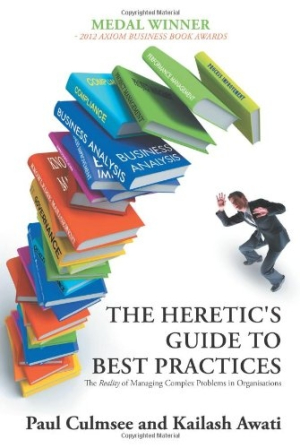The Heretic's Guide to Best Practices
The "Reality" of Managing Complex Problems in Organisations
- 2013 INDIES Finalist
- Finalist, Business & Economics (Adult Nonfiction)
- 2013 INDIES Finalist
- Finalist, Career (Adult Nonfiction)
This scrupulously researched, extremely readable work could impact how organizations execute projects and solve complex problems.
Modern business organizations of any appreciable size often wrestle with ways to improve their processes, execute major projects more efficiently, and find solutions to complex problems. Such challenges inevitably involve a lot of people, petty politics, and, as as result, widespread frustration. In an effort to get everyone working together, senior executives in many organizations rely on “best practices” to solve their problems.
The dirty little secret, according to business/technology consultants Paul Culmsee and Kailash Awati, is that “there is no best practice” to solve every problem, because “it is impossible to prescribe a one-size-fits-all process.” Instead, the authors offer a systematic approach that combines three main techniques to create a “holding environment in which open dialogue … can occur.”
The description of this approach may sound a bit daunting, but Culmsee and Awati lead the reader through a carefully organized, well-researched, three-part discussion that deftly combines theory with practice.
In part one, the authors begin by asking “some seriously loaded questions,” including, “Have you ever questioned an approach only to be told that it is a best practice and therefore cannot be questioned?” and “Have you ever sighed and blamed the ills of your organization on ‘culture’ or ‘that’s just the way things are done here’?” Using the apt analogy of a labyrinth game, in which the objective is to navigate a marble through a maze while avoiding hazards, Culmsee and Awati explain that “the duration and angle of the tilt we apply depends on where we are in the maze and the hazards that we see ahead of us.” The marble-in-a-maze board game makes several appearances throughout the book, each time with a relevant observation.
In part two, the authors delve deeply into visualization methods, focusing primarily on issue mapping, which is a visual way to show issues (or questions), positions (or ideas), and arguments. Culmsee and Awati apply issue mapping to a number of real-life examples, demonstrating its organizational value. They also discuss in detail several problem-structuring methods that provide “a much greater chance of developing shared understanding.” And they focus on “governance structures” that facilitate meaningful collaboration.
In part three, the authors share some case studies that show how all of these elements come together.
In terms of illustrating and explaining a dynamic method for complex problem solving, this book is a masterpiece. What’s more, the authors’ sense of humor makes the book fun to read. To some, the book’s content will seem heretical, especially in its dismissal of best practices as a myth. But what Culmsee and Awati really offer is an enlightened, ingenious perspective on how to get tough things done in large organizations. For project managers, business analysts, and even CEOs, The Heretic’s Guide to Best Practices may be just what the doctor ordered.
Reviewed by
Barry Silverstein
Disclosure: This article is not an endorsement, but a review. The publisher of this book provided free copies of the book and paid a small fee to have their book reviewed by a professional reviewer. Foreword Reviews and Clarion Reviews make no guarantee that the publisher will receive a positive review. Foreword Magazine, Inc. is disclosing this in accordance with the Federal Trade Commission’s 16 CFR, Part 255.

